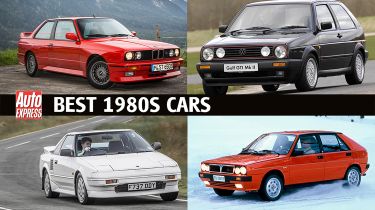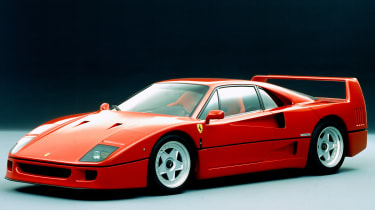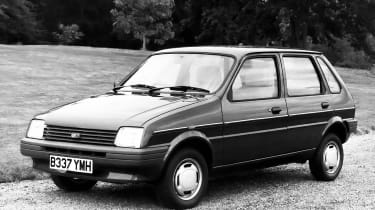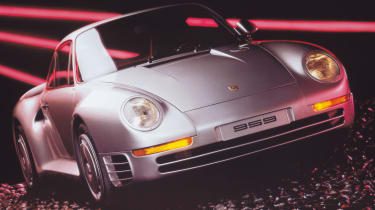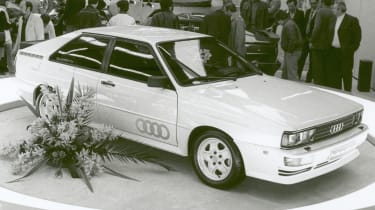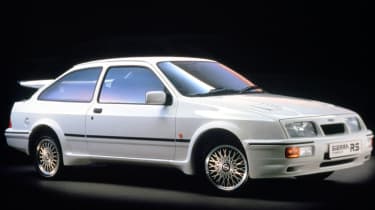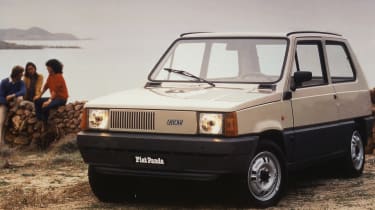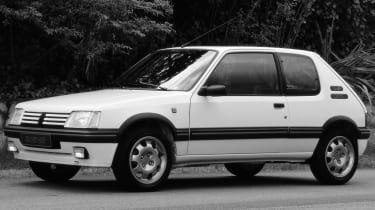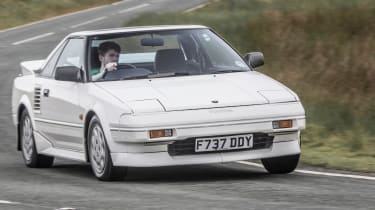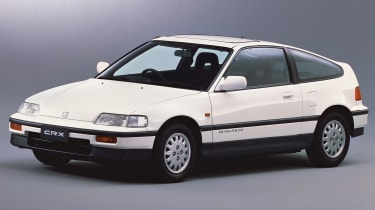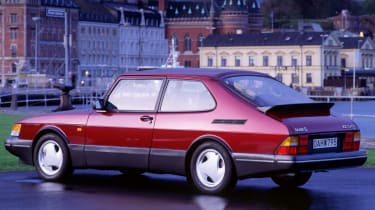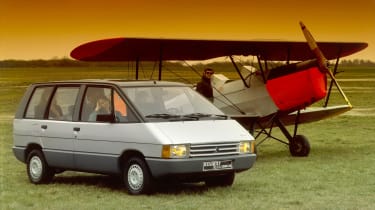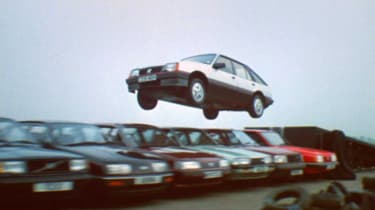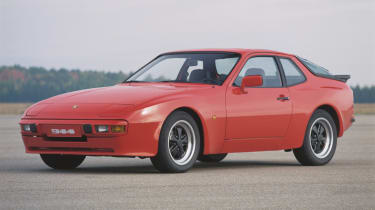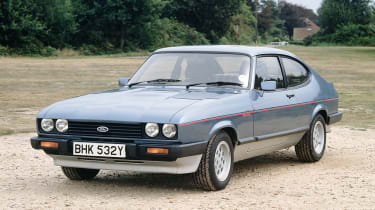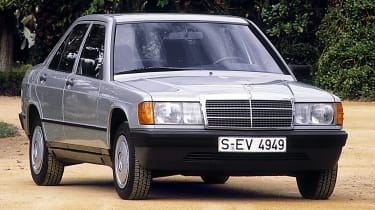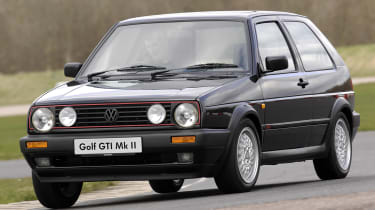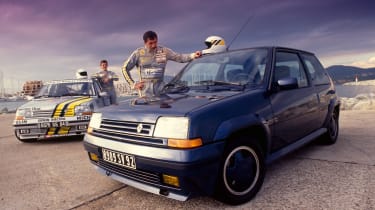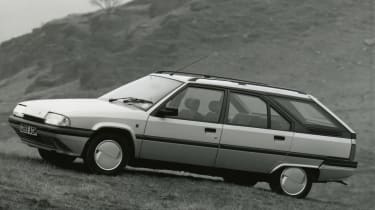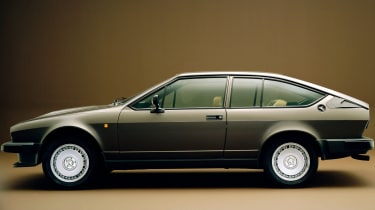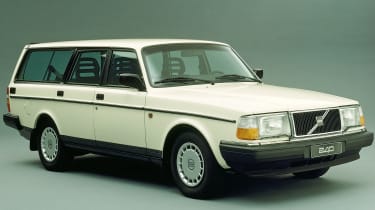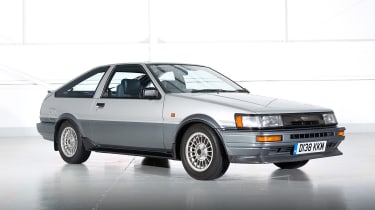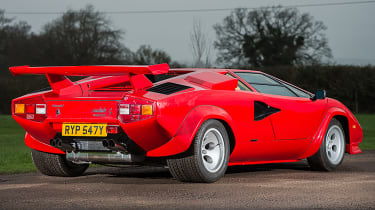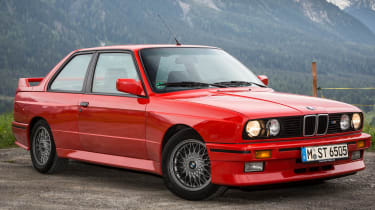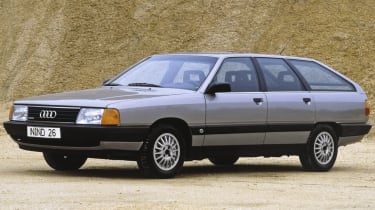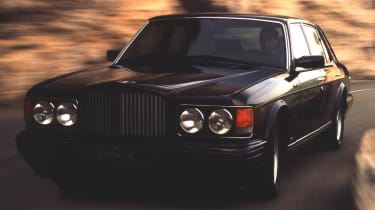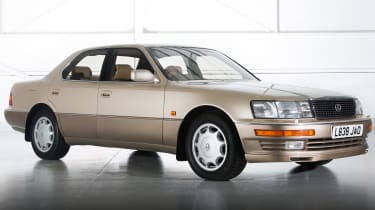Best 80s cars: the 30 greatest cars of the 1980s
We’ve picked our top 30 cars of the 1980s, stunning machines that broke new ground then and still stand out today.
The 1980s: a decade of big hair, red braces, shoulder pads, New Romantics, mobile phones the size of bricks, and the concept that greed is good. Greed is very good. Hands wrestled with Rubik’s Cubes, while the famous Sinclair ZX Spectrum put home computing at the fingertips of a nation.
Some of the new 1980s technology, such as the microwave, remains in use today. Other innovations, such as the video player, ‘ghetto blaster’ and pocket television, are more likely to be seen on an episode of Stranger Things.
It was a decade of immense change. A new generation of music lovers could be wired for sound thanks to the Sony Walkman. Many of the highest-grossing films remain popular today: E.T. the Extra-Terrestrial, Back to the Future, Ghostbusters and Beverly Hills Cop, to name but four.
If one kind of car could encapsulate the spirit of the 1980s, it would be the hot hatchback. Sports cars and coupes were out, as the UK embraced the front-wheel drive hatchback with a souped-up engine, go-faster stripes and bodykits. The Volkswagen Golf GTI kick-started the revolution, with the Peugeot 205 GTI, Ford Escort XR3/XR3i and Vauxhall Astra GTE following suit.
The hot hatch was affordable to buy, cheap to run and a huge amount of fun. Unfortunately, it was also pretty tricky to handle on the limit and alarmingly easy to steal. The price of car insurance rocketed as motorists paid the price for a car crime epidemic.
We’ve pulled together a list of 30 of the best cars of the 1980s. From fleet favourites to performance heroes, and sports cars to supercars, these are some of the cars that made the 80s such a formidable decade for motoring.
Ford Escort
Ford occupied three of the top four slots on the list of the best-selling cars of the 1980s. The Escort was top dog, with some 1.6 million cars sold across the decade. It was all change for Ford’s popular family car, with the Mk3 Escort debuting in the 1980s as a front-wheel drive hatchback.
There was an Escort for everyone, from a lowly base model hatchback or estate, to a performance gem fit for royalty. Princess Diana famously took delivery of a black Escort RS Turbo. Back in the real world, Britain’s working and middle classes got their kicks in the XR3 and XR3i.
Ferrari F40
To many people, this is the archetypal supercar of the 1980s. The pin-up star for a generation of young petrolheads. Built to celebrate Ferrari’s 40th anniversary, the F40 was the last new-car unveiling attended by Enzo Ferrari before he died in 1988. Such was the demand for the stripped-out and hardcore F40, Ferrari built 1,311 examples – far more than the planned 450.
Beneath the carbon fibre, Kevlar and aluminium body was a 2.9-litre twin-turbocharged V8 engine developing 471bhp. It was enough to send the F40 to a top speed of 201mph, hitting 60mph in under four seconds.
Austin Metro
Even the most ardent of British Leyland fans would struggle to label the Austin Metro as one of the best cars of the 1980s, but it was one of the most significant. Launched in the 1980s as a replacement for the Mini, it was promoted as ‘a British car to beat the world’. It’s another car with a Princess Diana connection, albeit during her days as Lady Diana Spencer.
There were five models available at launch: standard Metro, L, HLE, 1.3S and 1.3 HLS. The MG and Vanden Plas models are the most desirable, but when the Metro died, the Mini lived on.
Porsche 959
If the Ferrari F40 was the supercar at its analogue best, the Porsche 959 was a vision of supercars of the future. Like so many performance icons, the 959 was built for homologation purposes, specifically the company’s planned involvement in Group B rallying. This never happened, but the 959 did achieve a one-two at the gruelling Paris-Dakar in 1986.
Based on the 911, the 959 used an air-cooled flat-six engine with a pair of turbochargers, plus an electronically-controlled four-wheel drive system. The technical tour de force could hit 60mph in just 3.7 seconds, before reaching a top speed of 197mph.
Audi Quattro
Few cars can claim to have changed the shape of motorsport, the formula for performance cars and the fortunes of an entire company. The Audi Quattro of 1980 did just that, even though it was loosely based on the humble Audi 80 and sourced its power from the 200 saloon’s 2.1-litre turbocharged engine.
It was the Quattro’s four-wheel drive technology that led to Audi’s dominance of world rallying. The first road-going versions arrived in the UK in 1981, initially as left-hand drive models. It was so expensive, you have to wonder how Gene Hunt could afford to buy one. Fire up the calculator.
Ford Sierra
Ford shifted nearly a million Sierras between 1982 and 1993, making it the fourth best-selling car of the 1980s. It didn’t get off to the best of starts, with motorists reluctant to embrace the bold styling, which seemed at odds with the conservative Ford Cortina. The ‘jellymould’ styling must have looked otherworldly in 1982.
Success followed, helped by a combination of strong fleet sales, victories on the track and the legendary RS Cosworth. The Sierra dominated saloon car racing in the 1980s, forcing race authorities to tweak the rules to let the rest of the field catch up.
Fiat Panda
Fiat’s orders for the legendary Italian designer were simple but ambitious: “Giugiaro, make me a ‘French-style utility car which is identical in weight and manufacturing costs to the Fiat 126 but which obviously is larger and more comfortable.” His response was simple but brilliant: the Fiat Panda.
Unveiled at the 1980 Geneva Motor Show, the Panda was a triumph of good packaging and low-cost construction. The use of inexpensive flat windows saved money, while the flexible interior featured deckchair-style seats and a simple dashboard. The plucky Panda 4x4 was a hit with Italian hill farmers and residents of the Alps.
Peugeot 205 GTI
Few cars have aged as well as the pretty Peugeot 205. Often wrongly credited to Pininfarina, the styling was actually an in-house job, with Paul Bracq responsible for the interior. The Italian styling house worked on the 205 Cabriolet. However, there’s one variant of the 205 that stands head and shoulders above the others: the GTI.
Today’s prices reflect the fact that the Peugeot 205 GTI was the finest hot hatch of the 1980s. Two engines were available, and although the 1.9-litre version gets the most attention, some people prefer the balance of the 1.6-litre car.
Lancia Delta Integrale
Lancia dominated the World Rallying Championship in the late-80s and early-90s. It was all down to one car: the Delta Integrale. At the hands of the likes of Juha Kankkunen and Miki Biasion, the four-wheel drive and turbocharged Delta was almost unstoppable on the world’s rally circuits, kick-started by the Delta HF in 1987.
Unlike the wild Stratos and 037, the Delta was based on a humble, Giugiaro-designed five-door hatchback, but the extreme bodykit and wide arches of the later versions gave the Integrale real presence. It died in 1994 and proved to be irreplaceable.
Toyota MR2
The Toyota MR2 was Japan’s first mass-produced mid-engined sports car. “Rarely if ever have we been so totally confident about a new Toyota model as we are about the MR2”, said Toyota’s sales manager at its UK launch in 1985. The ‘Midship Runabout 2-seater’ was unveiled in Japan in 1983, before going on sale in its domestic market in June 1984.
It launched in the UK with a 122bhp 1.6-litre 16v engine sourced from the Toyota Corolla GT, which could propel the MR2 to 60mph in 8.2 seconds. The MR2 put to bed any thoughts that the hot hatch would kill the sports car.
Honda CRX
One road test described the Honda CRX as a “100bhp grown-up go-kart that defies virtually all attempts to be pigeon-holed”. The compact buzzbox was a shortened Honda Civic with an aerodynamic hatchback body and the styling of a coupe. Power was sourced from revvy 1.5-litre and 1.6-litre petrol engines.
The Mk1 made way for the equally brilliant Mk2 (pictured) in 1987, a car good enough to rival any hot hatch of the era. The CRX Del Sol of 1992 was a softer take on the CRX recipe with an innovative ‘targa’ roof.
Saab 900 Turbo
The Saab 900 technically arrived in the 1970s, but it deserves a place on this list. Essentially, the 900 came of age in the 1980s, with Saab developing the Turbo into an iconic performance car. The 175bhp 900 Turbo S arrived in 1984, followed by the limited-run 185bhp Carlsson in 1988.
Hatchback and saloon variants were joined by the 900 Convertible, which became one of the most popular four-seater convertibles of the 80s and 90s. The Saab 900 bowed out in 1993 with the Ruby special edition. It was the end of an era for the innovative Swedish company.
Renault Espace
While Renault can’t claim to have invented the MPV, the Espace was Europe’s first mass-market people carrier. Unlike van-based MPVs of the past, the Espace was designed from the inside out to offer maximum interior space and versatility. It could have been a Peugeot, but when the rival French company shunned the advances of Matra, Renault grabbed the baton.
Europe had never seen anything like it, to the point that the Espace made a disastrous start. Sales in the first month totalled nine, as European motorists failed to grasp the concept. Attitudes changed, with the Escape inspiring a new breed of family-friendly vehicles.
Vauxhall Cavalier
The Vauxhall Cavalier was one of the cars to benefit from the lukewarm reception to the Ford Sierra. Many buyers shunned the Sierra and turned to the conservative Cavalier, helping it to become the UK’s third most popular car of the 1980s. There was a time when the Little Chef car parks were filled with Cavaliers with a coat hanger dangling in the rear window.
The Mk2 Cavalier saw fleet buyers through most of the decade, before the curvy Mk3 Cavalier arrived in 1998. Although humble models were the most popular, the SRi and GSi versions offered some fun on the way back from the sales conference.
Lancia 037
The rear-wheel drive Lancia 037 upstaging the four-wheel drive Audi Quattro to win the 1983 title is one of the greatest stories in the history of the World Rally Championship. It was the last rear-wheel drive car to win.
In an interview, Walter Rohrl said it was his favourite rally car. “From the pure driving view it was the Lancia 037. It was a car made for my styling of driving – I don’t like to steer. I believe the only secret in driving is to steer as little as possible”. A total of 207 road-going Stradale versions were built.
Porsche 944
Porsche designed the 924 as an affordable sports car for Volkswagen, but when VW pulled out of the deal, bosses in Stuttgart were left with a car with no purpose. The company bought the rights and created an affordable version of its own. Some argued that it didn’t feel like a true Porsche, which led to the development of the 944.
This was the sports car the 924 should have been: wider, lower, stiffer and sharper. A new 2.5-litre four-cylinder engine delivered the performance, which gained a turbocharger for the launch of the 944 Turbo.
Ford Capri 2.8i
No other country embraced the Ford Capri quite like the UK. It delivered glamour and practicality to the family man, with the Capri enjoying its boom years in the 1970s. Time seemed to be running out when 1978 sales slumped to a third of the total in 1969. The launch of the Mk3 gave the Capri a new lease of life, with the 2.8 injection providing a much needed shot in the arm.
It was good enough to propel the Capri back into the top 10 sales chart, albeit with the backdrop of a growing image crisis. The 280 ‘Brooklands’ marked the end of production in December 1986.
Mercedes-Benz 190
It would be easy to underestimate the significance of the Mercedes-Benz 190 (W201). While there’s no denying the brilliance of the larger cars – the W124 could have secured a place on this list – the company lacked a presence in the compact executive segment. The 190 was Mercedes’ answer to the BMW 3 Series.
Mercedes spent a reported £600 million on its development to ensure the ‘baby-Benz’ shared all the hallmarks of its larger siblings. A presence in motorsport led to the launch of performance cars such as the 190E 2.3-16 and 2.5-16 Evolution models.
Volkswagen Golf GTI
No list of great cars of the 1980s would be complete without the Volkswagen Golf GTI. The Mk1 Golf GTI had popularised the concept of the hot hatch in the late 70s and early 80s, but the Mk2 was a more rounded product. Who can forget the iconic television advert starring Paula Hamilton?
It debuted with the 1.8-litre 8v engine from the original Golf GTI, but the launch of the 16v in 1986 sent the Golf to the top of the hot hatch league. The 205 GTI was marginally more fun, the 5 GT Turbo was faster, and the Escort XR3i had more universal appeal, but the Golf GTI was the complete package.
Renault 5 GT Turbo
So many other hot hatches could have made this list. The Fiat Uno Turbo is an underrated gem, the Daihatsu Charade GTti was the world’s most powerful 1.0-litre car, while many people will have fond memories of the Vauxhall Astra GTE. However, the Renault 5 GT Turbo stands out as a true great.
Turbocharging was a big deal for Renault. The 18 Turbo was one of the pioneers of the concept of a turbocharged family car, but the 5 GT Turbo had even more universal appeal. A top speed of 125mph and 0-60mph time of 7.5 seconds delivered strong Top Trumps credentials.
BMW M5
Understated to the point of anonymity, the E28 BMW M5 was one of the greatest performance cars of the 1980s. It was subtle by design, with BMW knowing that the car’s mature audience would prefer a sombre-suited saloon to anything too outlandish.
Its 3.0-litre straight-six engine lifted from the M1 supercar produced 278bhp. It was the perfect match for the sublime chassis, creating a package that was formidable enough to challenge the world’s greatest sports car. It was also one of the world’s first Q-cars.
Citroen BX
The saddest part of the Citroen BX story is how few are left in the UK. More than 2.3 million examples were built between 1982 and 1994, but this hasn’t stopped UK numbers falling to critical levels. As the old saying goes, you don’t know what you’ve got until it’s gone.
Marcello Gandini of Lamborghini Countach fame handled the styling. Who remembers the television advert showing Gandini leaving his house, walking past a Countach, then driving to work in a BX? The launch of a diesel version caught the attention of fleet buyers.
Alfa Romeo GTV6
Like so many other Alfa Romeo models, the GTV6 was far from perfect, but on the right road, and in the right circumstances, you wouldn’t want to be in any other car. Key to its appeal was a sublime Busso V6 producing 160bhp, which delivered one of the best soundtracks of any performance car.
Launched in 1981, the GTV6 could hit 60mph in 8.8 seconds, before reaching a top speed of 127mph. However, outright pace was less important than the sweet-sounding symphony and the fine handling.
Volvo 240
Although it was born in the 1970s, the Volvo 240 became a central part of family life in the 1980s. Solid construction, absolute safety and a boot large enough for any antiques fair made the Volvo estate the perfect family wagon before the arrival of the MPV and the SUV.
Rear-wheel drive meant that it was also pretty decent to drive, especially if you opted for the GLT variant. The Volvo 240 Turbo became a successful race car, with Thomas Lindstrom and Gianfranco Brancatelli winning the 1985 European Touring Car Championship.
Toyota Corolla AE86
The rear-wheel drive Toyota Corolla AE86 secured back-to-back British Touring Car Championship victories in 1986 and 1987, with Chris Hodgetts steering the car to victory. His car featured a 1.6-litre twin-cam engine producing 190bhp, with the road-going versions making do with 123bhp.
It arrived in 1983, just as the market was embracing front-wheel drive hot hatches. While some rivals could be described as ‘blunt instruments’, the AE86 featured the likes of all-round disc brakes, coil springs and a limited-slip differential. Today, the AE86 is a legend of the drift scene and prices reflect this.
Lamborghini Countach
Many would argue that the original LP400 is peak Lamborghini Countach. Marcello Gandini’s masterpiece was at its best in its purest form, without the wild and outlandish addenda of the 1980s. However, the Countach somehow managed to mirror the tastes of the 80s – the flared arches and huge spoilers were the big hair of the automotive world.
The LP500S launched with power sourced from a 4.8-litre V12 producing a mighty 375bhp, while the Countach Quattrovalvole (QV) upped the ante with 455bhp and a 183mph top speed. Lamborghini called time on the Countach with the Anniversary of 1990.
BMW M3
Even the E30 BMW M3’s left-hand drive only status didn’t stop it from becoming one of the most desirable performance cars of the 1980s. It was homologated to enable BMW to go racing against the Mercedes-Benz 190E Cosworth and Ford Sierra RS Cosworth, with power sourced from a four-cylinder, 16v engine derived from the six-cylinder unit in the M1.
Within a year of its launch at the 1985 Frankfurt Motor Show, sales had exceeded the 5,000 units required for homologation purposes. To satisfy demand, BMW launched Evolution and Evolution II models.
Audi 100
Audi began the decade with the world’s first mass-produced four-wheel drive performance car, but the Quattro wasn’t the only highlight of the 80s. Take the Audi 100, which arrived in 1982. At the time, it featured the best aerodynamics of any production car, while lightweight construction and the option of four-wheel drive set it apart from rival offerings.
It was also the first saloon to feature flush-fitting side windows, which helped the 100 to achieve a record-breaking drag coefficient of 0.30cd.
Bentley Turbo R
If you’ve ever wondered what it feels like to drive a five-star hotel room at 135mph, the Bentley Turbo R is a good place to start. It arrived in 1985 as a development of the old Mulsanne Turbo, with more power thanks to the fitment of Bosch fuel injection. The suspension was also upgraded to take the Turbo R even further away from the platform-sharing Rolls-Royce Silver Spirit.
Its immense performance was sourced from a 6.75-litre V8 engine, with the top speed electronically limited to 135mph. Sales were superb for a hand-built car, with some 4,815 examples leaving the factory.
Lexus LS 400
We conclude our look at some of the best cars of the 1980s with the Lexus LS 400. It arrived at the 1989 Detroit Auto Show and would become one of the defining cars of the 1990s. It was the result of near-obsessive levels of development, with Toyota determined to upstage the Mercedes-Benz S-Class. Nothing was left to chance.
A fitting way to end this feature and the perfect segue to a potential look at the best cars of the 1990s. The LS 400 would be one of the first cars on the list, swiftly followed by the Mazda MX-5. The sports car may have arrived in 1989, but it went on to define the automotive decade that followed.
Have you ever owned any of these 1980s classics? Let us know in the comments...
